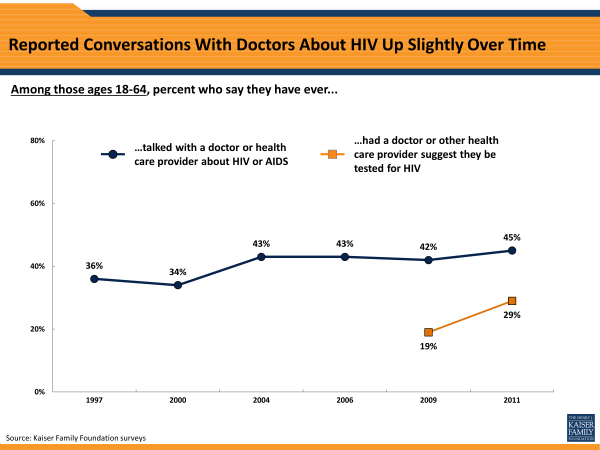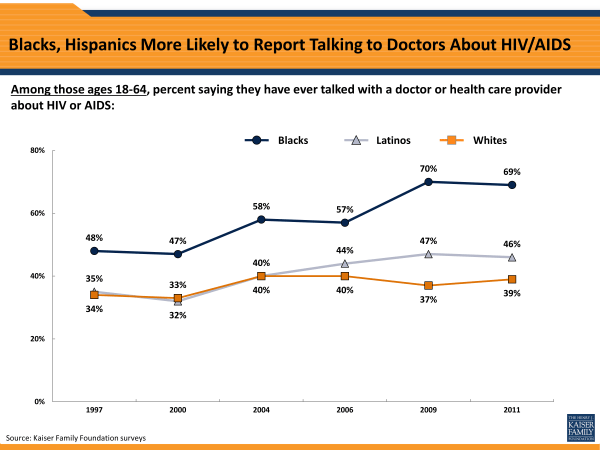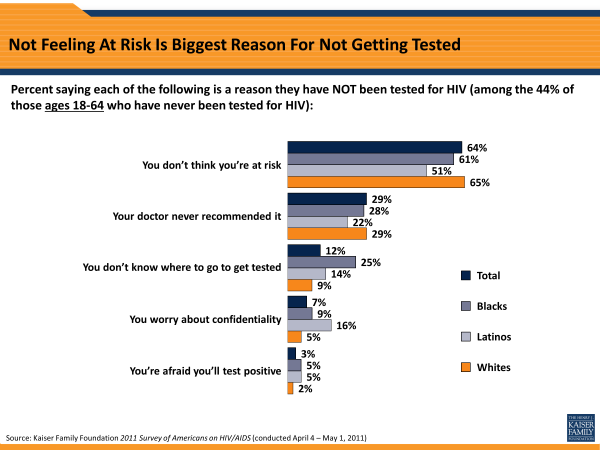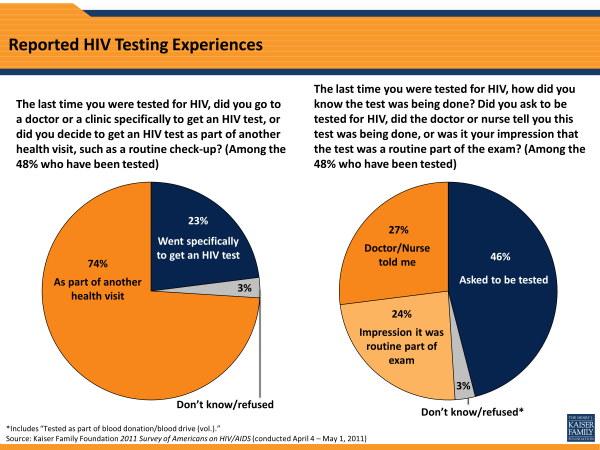HIV/AIDS at 30: A Public Opinion Perspective
Section 4: Americans Talk About Testing
According to the U.S. Centers for Disease Control and Prevention (CDC), an estimated 21 percent of the more than 1.1 million Americans living with HIV/AIDS today do not know their status,1 despite evidence that early diagnosis not only improves lives of those who are infected but also has been shown to significantly reduce transmission. In 2006, the CDC began recommending routine HIV testing in health care settings for everyone between the ages of 13 and 64.2 And indeed, over time, survey data show a small increase in the share of non-elderly adults who report discussing HIV with their doctors, and a recent increase in the share saying their doctor suggested they get tested. But so far this hasn’t translated into an increase in reported rates of actually getting an HIV test. Self-reported rates of HIV testing among the non-elderly population in the U.S. have remained stagnant for nearly a decade and a half. While certain groups at higher risk for HIV infection, including blacks, Latinos, and younger adults, are more likely than others to report having been tested for HIV, testing rates for these groups are also roughly the same today as they were in 1997.
More Saying Doctor Has Suggested HIV Test, But Proportion Who Report Being Tested is Unchanged
The new survey finds that the proportion of non-elderly adults (those ages 18-64) saying their doctor has ever recommended an HIV screening is up from 2009 (from 19 percent to 29 percent). This comes a few years after the CDC recommended routine screening in 2006. More broadly, 45 percent of non-elderly adults in 2011 say they have ever talked with a doctor or other health care provider about HIV, a share that has been steady for the past seven years, but is up roughly ten percentage points from the late 1990’s and early 2000’s.
The survey data does not find, however, a concurrent increase in self-reported rates of actually getting an HIV test. In 2011, roughly one in five (21 percent) non-elderly adults say they have been tested for HIV during the past 12 months, a share that has remained statistically unchanged since 1997 (when it sat at 19 percent). The proportion of non-elderly who say they have ever had an HIV test increased somewhat from about four in ten in 1997 to just over half in 2004, where it remains today (54 percent).
Blacks, Younger Adults More Likely To Report Being Tested, But Rates For These Groups Are Also Flat
Perhaps reflecting their greater proximity to and experience with HIV described above, blacks are much more likely than whites to say they have ever had an HIV test (77 percent versus 49 percent among the non-elderly), and nearly three times as likely as whites to report having been tested in the previous year (43 percent versus 15 percent). Non-elderly Latinos are somewhat more likely than whites, but not nearly as likely as blacks, to report having been tested (58 percent ever, 24 percent in the past year).
| Figure 40: Percent Who Report Being Tested For HIV By Age And Race/Ethnicity | ||||||||
| Percent saying they have ever been tested | Percent saying they were tested in the past 12 months | |||||||
| Total | Blacks | Latinos | Whites | Total | Blacks | Latinos | Whites | |
| Adults (18 and older) | 48% | 72% | 55% | 42% | 18% | 39% | 23% | 13% |
| Non-elderly (18-64) | 54 | 77 | 58 | 49 | 21 | 43 | 24 | 15 |
| Age 18-29 | 48 | 71 | 51 | 41 | 26 | 47 | 29 | 20 |
| Age 30-49 | 67 | 83 | 68 | 64 | 22 | 45 | 28 | 17 |
| Age 50-64 | 43 | 73 | 46 | 37 | 14 | 36 | 10 | 10 |
| Age 65 and older | 13 | * | * | 11 | 4 | * | * | 4 |
| *Survey contained too few interviews with blacks and Latinos age 65 and older for reporting. | ||||||||
Adults under age 50 also report higher rates of testing than their older counterparts. Those ages 30-49 are the cohort most likely to report having ever been tested (67 percent). While one might expect higher rates of recent testing among the youngest age cohort, those ages 18-29 and 30-49 are about equally likely to say they have been tested in the past year (26 percent and 22 percent, respectively). Both of these age cohorts are significantly more likely to report recent testing than those ages 50-64 (14 percent). Considering race, ethnicity and age, the highest reported rates of testing in the previous year are among blacks under the age of 50. Nearly half of blacks ages 18-29 (47 percent) and ages 30-49 (45 percent) say they have been tested in the past 12 months.
In addition to these differences in reported testing rates, non-elderly blacks are far more likely than whites or Latinos to report having talked to a doctor or health care provider about HIV or AIDS. Overall, roughly seven in ten say they have done so at some point, compared to roughly four in ten of non-elderly whites, and the gap between the two groups has grown over time as blacks have begun reporting doctor consultations at a higher rate. Between 1997 and 2011, the proportion of non-elderly whites who have talked to a health care provider about HIV/AIDS is up 5 percentage points, while the proportion of non-elderly blacks reporting the same is up 21 percentage points.
| Figure 42: Percent Saying A Doctor Or Other Health Care Provider Has Ever Suggested They Be Tested For HIV | ||
| 2009 | 2011 | |
| Total age 18-64 | 19% | 29% |
| Blacks age 18-64 | 31 | 41 |
| Latinos age 18-64 | 29 | 40 |
| Whites age 18-64 | 16 | 24 |
Similarly, both blacks and Latinos are more likely than whites to report ever having had a doctor suggest getting an HIV test. Roughly four in ten non-elderly blacks and Latinos say they’ve ever received such a recommendation, compared with about a quarter of non-elderly whites, shares that have increased across all racial groups since 2009.
But again, despite these apparent increases in communications with health care providers and in reports of doctors suggesting testing, these groups have seen no meaningful change over time in reported rates of actually being tested. Among non-elderly blacks and Latinos, as well as among all adults ages 18-29 and among blacks ages 18-29, the shares who report getting testing in the previous twelve months have changed little—or not at all—since 1997.
| Figure 43: Percent Saying They Have Been Tested For HIV In The Past 12 Months | ||||||
| 1997 | 2000 | 2004 | 2006 | 2009 | 2011 | |
| Blacks age 18-64 | 39% | 33% | 38% | 41% | 40% | 43% |
| Latinos age 18-64 | 24 | 23 | 30 | 28 | 28 | 24 |
| Whites age 18-64 | 16 | 17 | 18 | 16 | 14 | 15 |
| All adults age 18-29 | 26 | 30 | 35 | 26 | 30 | 26 |
| Blacks age 18-29 | 45 | 50 | 48 | * | 47 | 47 |
| *2006 survey contained too few interviews with blacks age 18-29 for reporting. | ||||||
Among Young Adults, Women Are More Likely Than Men To Report Getting Tested
Overall, non-elderly men and women report similar rates of HIV testing. However, among adults under age 30, women are significantly more likely than men to report having had an HIV test, both ever and in the past 12 months. This may be due to the fact that women are more likely than men to go to the doctor for regular check-ups, and that this is an age when many women are having children, and most health care providers routinely screen for HIV among pregnant women, as recommended by national guidelines.
| Figure 44: Reported HIV Testing And Communication With Providers By Age And Gender | ||||||||
| Percent saying they have ever been tested for HIV | Percent saying they were tested for HIV in the past 12 months | Percent saying a doctor/ provider ever suggested they be tested for HIV | Percent saying they’ve ever talked with a doctor/ provider about HIV | |||||
| Men | Women | Men | Women | Men | Women | Men | Women | |
| Age 18-64 | 52% | 57% | 22% | 20% | 25% | 34% | 41% | 49% |
| Age 18-29 | 44 | 53 | 22 | 33 | 22 | 36 | 42 | 56 |
Biggest Reason For Testing: “Seemed Like A Good Idea”; Biggest Reason For Not: “I’m Not At Risk”
The most commonly reported reason for getting an HIV test is that it “just seemed like a good idea” (77 percent). Of those who report having ever been tested, survey findings suggest that testing may be more routine among young people and among blacks of all ages. Almost half (47 percent) of 18-29 year-olds who have been tested say it’s something they do every year, compared with about a quarter of those over age 30. Similarly, 48 percent of blacks who’ve been tested say they do it yearly, compared with a third of Latinos and 22 percent of whites.
| Figure 45: Among Those Who Have Been Tested, Percent Saying Each Of The Following Was A Reason | |||||||
| Total | Age 18-29 | Age 30-49 | Age 50-64 | Black | Latino | White | |
| It just seemed like a good idea | 77% | 83% | 78% | 72% | 86% | 84% | 72% |
| Your doctor or other health care provider suggested you get tested | 32 | 30 | 31 | 32 | 29 | 40 | 30 |
| It’s something you do every year | 29 | 47 | 26 | 22 | 48 | 33 | 22 |
| You were concerned that you might be infected | 24 | 22 | 24 | 27 | 20 | 26 | 24 |
| A partner suggested or asked that you get tested | 11 | 12 | 12 | 9 | 11 | 10 | 12 |
The most commonly reported reason for never having been tested is not feeling at risk. This is true for young adults as well as overall (63 percent each). While not feeling at risk is the most often-cited reason for all racial and ethnic groups, a quarter of non-elderly blacks who have never been tested say they don’t know where to go to get tested, compared to just 9 percent of non-elderly whites and 14 percent of non-elderly Latinos, suggesting a missed opportunity for public health.
Most Don’t Express Fear Of Testing-Related Stigma, But Still A Concern For Some
For the past five years, Kaiser surveys have also measured the perceived stigma attached to getting an HIV test. While the proportion who believe people would think less of them if they heard they had been tested dropped from 21 percent to 16 percent between 2006 and 2009, it remained at 16 percent this year. Overall, the large majority (69 percent) say they don’t think their friends would care either way, while 9 percent say people would think more of them for being tested.
While a majority across age and racial/ethnic groups say getting tested for HIV would have no impact on how their friends perceive them, blacks (22 percent) are much more likely than whites (5 percent) or Latinos (11 percent) to say people would think more of them if they were tested. It’s also notable that among young adults ages 18-29, a key target group for testing, roughly one in six (17 percent) believe getting tested would cause people they know to think less of them (compared to 12 percent of 30-49 year olds).
| Figure 47: Percent Who Say People They Know Would Think Less/More Of Them If They Were To Be Tested | ||||||||
| Total | Age 18-29 | Age 30-49 | Age 50-64 | Age 65+ | Blacks | Latinos | Whites | |
| Less of you | 16% | 17% | 12% | 19% | 19% | 7% | 17% | 17% |
| More of you | 9 | 11 | 10 | 6 | 4 | 22 | 11 | 5 |
| No difference | 69 | 69 | 71 | 68 | 65 | 68 | 64 | 71 |
Most Who Were Tested Did So As Part Of Another Health Visit
Among the 48 percent of all adults who say they have ever been tested for HIV, most report getting the test as part of another health visit (74 percent) whereas about a quarter (23 percent) report going to the doctor specifically for the test. Nearly half (46 percent) of those who have been tested say they asked to be tested, while about a quarter (27 percent) say the doctor or nurse informed them they were being tested, and another quarter (24 percent) say they had the impression the test was a routine part of the exam.
Reported Testing For STDs Other Than HIV
The CDC reports there is strong evidence that the presence of other sexually transmitted diseases (STDs) increases the likelihood of both transmitting and acquiring HIV, and recommends that early detection and treatment of curable STDs be a major component of HIV prevention programs at national, state, and local levels.3
Among non-elderly adults, four in ten (40 percent) say they have ever been tested for a sexually transmitted disease (STD) other than HIV, and 14 percent say they had such a test in the previous year. A somewhat larger share say they have talked with a doctor or health care provider at some point about any STD besides HIV (49 percent), though just 23 percent say a provider ever suggested they receive such a test. Of those who say they were tested, about half (51 percent) say they specifically asked to be tested, while two in ten say the doctor or nurse told them they were being tested, and 28 percent were under the impression it was a routine part of the exam.
Reported STD testing is more common among the young—almost half (46 percent) of those under age 50 say they’ve ever been tested for an STD, while testing in the previous year is most commonly reported by those ages 18-29 (28 percent). Among adults under age 30, about six in ten across all racial and ethnic groups say they’ve ever talked with a doctor about STDs. Young blacks stand out as more likely than their young white and Latino counterparts to report being tested for an STD, both ever and in the past year, and to say testing was recommended to them by a doctor.
As with HIV, women overall, and young women in particular, are more likely than their male counterparts to report talking to their providers and getting tested for STDs. Six in ten women under 30 (61 percent) say they’ve ever been tested for an STD other than HIV, compared with 36 percent of men in this age range. And the disparity is even bigger for recent STD testing—44 percent of young women compared with 17 percent of young men say they were tested in the past 12 months. While these gender gaps exist across racial and ethnic groups, the differences are smaller for blacks, with white and Latino men standing out as having the lowest reported rates of STD testing among young adults.
Part of the gender differences may be due to the fact that young women are more likely than young men to be engaged in ongoing, routine health care, including yearly gynecological exams, during which providers may recommend STD testing. For most women of reproductive age, their yearly exam will include a pap smear, which some women may have interpreted as an STD test when responding to these questions. And in fact, among young women who say they were tested for an STD, 38 percent say they thought such testing was a routine part of the exam (compared with 19 percent of young men who were tested). It’s possible that at least some of these young women were under the false impression that their yearly pap smear was testing for STDs that are not actually detected by such a test. Conversely, young men who report being tested for STDs were more likely to say they specifically asked to be tested (65 percent, compared with 40 percent of young women).
Perhaps not surprisingly, the survey data indicate that testing for HIV and other sexually transmitted diseases may often go hand-in-hand. Eight in ten of those who report having ever had an STD test say they’ve also been tested for HIV, compared with just three in ten of those who’ve never been tested for another STD. The same is true for recent testing—about seven in ten (69 percent) of those who were tested for an STD in the past year also report receiving a recent test for HIV, compared with just 11 percent of those who haven’t had an STD test in the past 12 months.
| Figure 49: Reported STD Testing And Communication With Providers By Age, Race, And Gender/td> | ||||||||
| Percent saying they have ever been tested for an STD other than HIV | Percent saying they were tested for an STD in the past 12 months | Percent saying a doctor/ provider ever suggested they be tested for an STD | Percent saying they’ve ever talked with a doctor/ provider about STDs | |||||
| Total age 18-64 | 40% | 14% | 23% | 49% | ||||
| Age 18-29 | 46 | 28 | 29 | 61 | ||||
| Age 30-49 | 46 | 13 | 27 | 51 | ||||
| Age 50-64 | 25 | 3 | 11 | 36 | ||||
| Blacks age 18-29 | 65 | 43 | 41 | 66 | ||||
| Latinos age 18-29 | 44 | 29 | 28 | 57 | ||||
| Whites age 18-29 | 43 | 24 | 28 | 62 | ||||
| Men | Women | Men | Women | Men | Women | Men | Women | |
| Total age 18-64 | 35% | 45% | 10% | 19% | 17% | 30% | 46% | 53% |
| Total age 18-29 | 36 | 61 | 17 | 44 | 18 | 45 | 55 | 69 |
| Blacks age 18-29 | 61 | 69 | 33 | 54 | 37 | 45 | 65 | 67 |
| Whites age 18-29 | 31 | 60 | 13 | 40 | 11 | 51 | 53 | 73 |
| Latinos age 18-29 | 32 | 67 | 16 | 55 | 23 | 38 | 50 | 70 |





